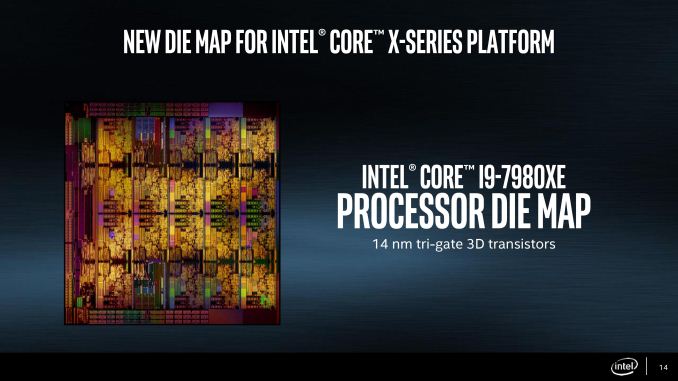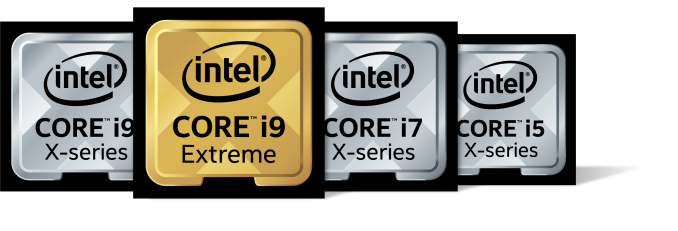The Intel Core i9-7980XE and Core i9-7960X CPU Review Part 1: Workstation
by Ian Cutress on September 25, 2017 3:01 AM ESTIntel Core i9-7980XE and Core i9-7960X Conclusion
In the 2000s, we had the frequency wars. Trying to pump all the MHz into a single core ended up mega-hurting one company in particular, until the push was made to multi-core and efficient systems. Now in the 2010s, we have the Core Wars. You need to have at least 16 cores to play, and be prepared to burn power like never before. With today’s launch, Intel has kicked their high-end desktop offerings up a notch, both in performance and power consumption.
Pun density aside, both Intel and AMD are pursuing a many-core strategy when it comes to the high-end desktop. Both manufacturers have the same story in their pockets: users need more multi-threaded performance, either for intense compute or for a heavy scoop of compute-based multi-tasking, to include streaming, encoding, rendering, and high-intensity minesweeper VR all at the same time. Due to having so many cores, single threaded performance while under load can be lower than usual, so both companies focus on throughput rather than responsiveness.
The Core i9-7980XE is Intel’s new top-of-the-line HEDT processor. Coming in at 18-cores and drawing 165W, this processor can reach 4.4 GHz at top turbo or 3.4 GHz on all-core turbo. At $1999, it becomes the most expensive (?) consumer focused processor on the market. It is priced at this level for two reasons: first such that it doesn’t cannibalize Intel’s enterprise sales which have a higher profit margin, but also due to Intel’s product stack it fills up several price points from $300 all the way to $2000 now, and with it being Intel’s best consumer processor, they are hoping that it will still sell like hot cakes.
Our performance numbers show that Intel’s best multi-core consumer processor is deserving of that title. In most of our multi-core tests, Intel has a clear lead over AMD: a combination of more cores and a higher single threaded performance compensates for any frequency difference. For anyone with hardcore compute, Intel gets you to the finishing line first in almost every scenario. AMD does win on a few benchmarks, which is something we saw when Johan tested the enterprise versions of Intel's and AMD's CPUs in his review, where he cited AMD’s FP unit as being the leading cause of the performance improvement.
There are going to be three cautionary flags to this tale based on our testing today, for anyone looking at Skylake-X, and they all start with the letter P: Power, Platform, and Price.
Power: In our testing, Intel’s cores can consume between 20W and 7.5W per core, which is a large range. When all cores are at load, as well as the mesh and DRAM controllers, the Core i9-7980XE draws over 190W, well above the TDP rating of 165W. This will cause concern for users that take the TDP value as rote for power consumption – and for any users thinking of overclocking it might also be worth investing in custom cooling loops. The processors from AMD consume ~177W at load, which for two cores less is about the same ballpark.
Platform: X299 motherboards are designed to handle Kaby Lake-X, Skylake-X LCC and Skylake-X HCC processors. Almost all the motherboards should be geared towards the high-end processors which makes platform compatibility a bit of a non-issue, however testing by others recommends some form of active cooling on the power delivery. When investing $1999 in a processor, especially if a user is considering overclocking, it is likely that a good motherboard is needed, and not just the bargain basement model. Some users will point to the competition, where AMD's processors offer enough lanes for three x16 GPUs and three PCIe 3.0 x4 storage devices from the processor at the same time, rather than reduced bandwidth for 3-way and requiring storage to go through the chipset.
Price: $1999 is a new record for consumer processors. Intel is charging this much because it can – this processor does take the absolute workstation performance crown. For high performance, that is usually enough – the sort of users that are interested in this level of performance are not overly interested in performance per dollar, especially if a software license is nearer $10k. However for everyone else, unless you can take advantage of TSX or AVX-512, the price is exorbitant, and all arrows point towards AMD instead. Half the price is hard to ignore.
Users looking at the new processors for workstation use should consider the three Ps. It’s not an easy task, and will highly depend on the user specific workflow. The recommendations ultimately come down to three suggestions:
- If a user needs the top best workstation processor without ECC, then get Skylake-X.
- If a user needs ECC or 512GB of DRAM, Xeon-W looks a better bet.
- If a user has a strict budget or wants another GPU for compute workloads, look at Threadripper.
For those weighing up the Core i9-7960X compared to the Core i9-7980XE, part of me wants to say ‘if you’re going for cores and prepared to spend this much, then go all the way’. If the main purpose is throughput, for the benchmarks that matter, the 7980XE is likely to provide benefit. For multi-taskers, the benefits are less clear, and it would be interesting to get the Core i9-7940X and Core i9-7920X in for testing.













152 Comments
View All Comments
extide - Monday, September 25, 2017 - link
No, TDP should include Turbo as that is part of the base/stock operation mode of the CPU.IGTrading - Monday, September 25, 2017 - link
TDP = Total Design Power by definition.This is used to design the motherboard and the cooling system to give designers a clear limit over which the system doesn't go unless it is purposely overcloked.
Wikipedia : "The thermal design power (TDP), sometimes called thermal design point, is the maximum amount of heat generated by a computer chip or component (often the CPU or GPU) that the cooling system in a computer is designed to dissipate under any workload."
Intel : "TDP (Thermal Design Power) Intel defines TDP as follows: The upper point of the thermal profile consists of the Thermal Design
Power (TDP) and the associated Tcase value. Thermal Design Power (TDP) should be used for
processor thermal solution design targets. TDP is not the maximum power that the processor can
dissipate. TDP is measured at maximum TCASE.1"
Intel : "Due to normal manufacturing variations, the exact thermal characteristics of each individual processor are unique. Within the specified parameters of the part, some processors may operate at a slightly higher or lower voltage, some may dissipate slightly higher or lower power and some may draw slightly higher or lower current. As such, no two parts have identical power and thermal characteristics.
However the TDP specifications represent a “will not exceed” value. "
This is what we've understood by TDP in the past 21 years while in IT hardware industry.
If you have a different definition, then perhaps we're talking about different things.
whatevs - Monday, September 25, 2017 - link
Specification for 7980xe says "Thermal Design Power (TDP) represents the average power, in watts, the processor dissipates when operating at Base Frequency with all cores active under an Intel-defined, high-complexity workload. Refer to Datasheet for thermal solution requirements."There's a different specification for electrical design. This is not your ancient Xeon TDP.
IGTrading - Monday, September 25, 2017 - link
You mean the definition of TDP should change every year to suit Intel's marketing ?! :)"Ancient" Xeon TDP ?! :)
I've quoted Intel's own definition.
If the company just came up with a NEW and DIFFERENT definition just for the Core i9 series, then that's just plain deceiving marketing, changing with the wind (read : new generation of products) .
Plus, why the heck are they calling it TDP ?!
If they now claim that TDP "represents the average power, in watts, the processor dissipates when operating at Base Frequency with all cores active " then they basically use AMD's ACP from 2011.
What a load of nonsense from Intel ...
https://www.intel.com/content/dam/doc/white-paper/...
whatevs - Monday, September 25, 2017 - link
You have quoted 6 year old Xeon definition, different products have different operating conditions, deal with it.Spunjji - Monday, September 25, 2017 - link
Your name suggests that you're kind of a dick and your comments confirm it. Your point is weak and doesn't at all do the work you think it does.whatevs - Monday, September 25, 2017 - link
You may be unhappy with what Intel promised you, but to claim that you could burn a system with increased power usage from turbo clocks is ridiculous, thermal throttling is not fire, and it's ridiculous to argue on a cpu that can run overclocked at >400w power consumption.Notmyusualid - Monday, September 25, 2017 - link
+1wolfemane - Tuesday, September 26, 2017 - link
You can't talk rationale with a loyalist sympathizer. TDP is a set definition in the industry and one Intel seems to be misleading about with their Extreme HEDT CPU. That seems to be a fact clearly made among almost all reviews of the 7980xe.I think I read a few articles yesterday talking about how the 7980xe was having major issues and wasn't boosting correctly but showing high power draw. But yesterday was a long time ago and I cant remember where I read that.
someonesomewherelse - Saturday, October 14, 2017 - link
So why not call it 'Average Design Power - ADP'?